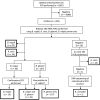Prevalence of Babesia spp. and clinical characteristics of Babesia vulpes infections in North American dogs
- PMID: 31334887
- PMCID: PMC6766513
- DOI: 10.1111/jvim.15560
Prevalence of Babesia spp. and clinical characteristics of Babesia vulpes infections in North American dogs
Abstract
Background: Babesiosis is an important cause of thrombocytopenia and hemolytic anemia in dogs. Babesia vulpes, reported in European dogs and North American foxes, rarely has been reported in domestic North American dogs. Newly optimized polymerase chain reaction (PCR) primers facilitate more sensitive amplification of B. vulpes DNA.
Objectives: To determine the prevalence of Babesia sp. infections in dogs being tested for Babesia infection, and to describe co-infections and clinicopathologic abnormalities in B. vulpes positive dogs.
Animals: Dog blood or tissue samples (n = 9367) submitted to a diagnostic laboratory between June 2015 and June 2018 were tested using an optimized Babesia PCR assay.
Methods: Comprehensive canine vector-borne disease diagnostic testing was performed on convenience samples.
Results: Babesia sp. DNA was amplified from 269/9367 (2.9%) North American dogs. Babesia sp. infections included B. gibsoni monoinfection (157; 1.7%), B. vulpes monoinfection (19; 0.20%), and B. gibsoni and B. vulpes coinfection (29; 0.31%). Forty-three of the 48 total B. vulpes-infected dogs were American Pit Bull Terrier-type breeds, of which 36 historically were involved with dog fights. Coinfections with Mycoplasma, Dirofilaria immitis, or Wolbachia and coexposures to Bartonella, Ehrlichia, and Rickettsia spp. were documented in B. vulpes-infected dogs. Clinicopathologic data in B. vulpes-infected dogs both with and without coinfections included anemia, thrombocytopenia, hyperglobulinemia, hypoalbuminemia, and proteinuria.
Conclusions and clinical importance: Babesia vulpes infection in domestic North American dogs is commonly found in conjunction with other coinfections, including B. gibsoni and hemotropic Mycoplasma. Similar to B. gibsoni, dog-to-dog transmission of B. vulpes may be a frequent mode of transmission.
Keywords: B. vulpes; Babesia; hemolytic anemia; prevalence; tick; vector-borne disease.
© 2019 The Authors. Journal of Veterinary Internal Medicine published by Wiley Periodicals, Inc. on behalf of the American College of Veterinary Internal Medicine.
Conflict of interest statement
Nanelle R. Barash received a Boehringer‐Ingelheim Resident‐Postdoctoral Scholar Sponsorship.
Figures
References
MeSH terms
LinkOut - more resources
Full Text Sources
Miscellaneous



